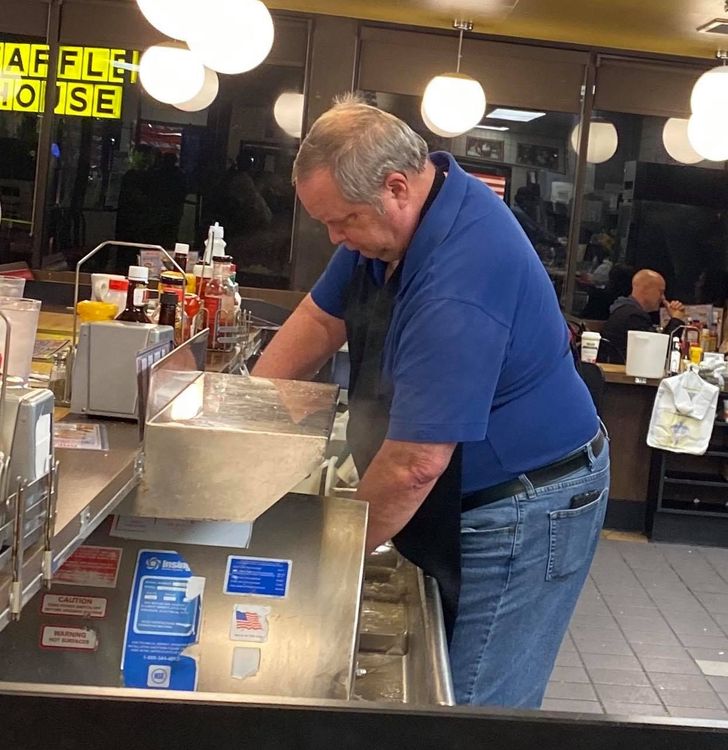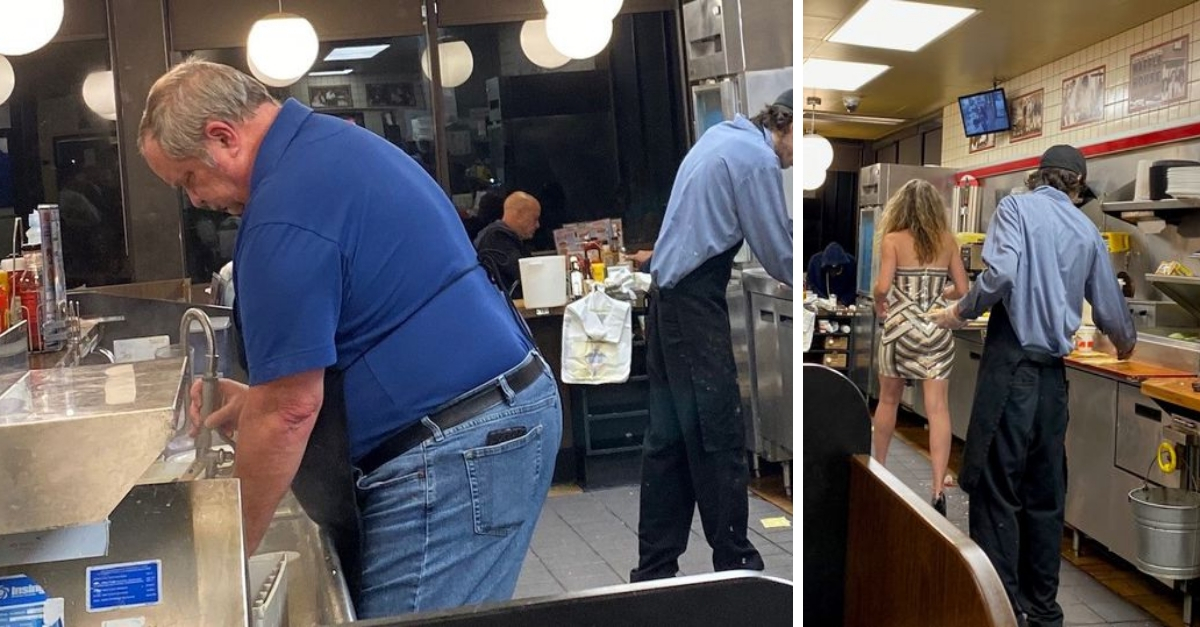When Strangers Became Heroes: How a Midnight Waffle House Turned Hungry Customers into an Impromptu Team of Helpers.
It was a typical Sunday night at a Waffle House in Birmingham, Alabama—or at least it was supposed to be. Ethan Crispo had walked in around midnight, expecting the usual late-night crowd, coffee, and sizzling hashbrowns. What he found, however, was anything but ordinary.
Inside, about thirty hungry customers were scattered across the tables and counters, all quietly hoping for a meal. Behind the counter, there was only one employee on duty, a young man named Ben, who was clearly overwhelmed. Orders were piling up, the coffee pot was running low, and the cash register beeped incessantly. Crispo watched as Ben frantically tried to manage everything: taking orders, cooking food, bussing tables, and keeping the line moving. The look on his face was a mix of panic and sheer determination—he was doing his best, but it was obvious he needed help.

Then something remarkable happened. Crispo noticed Ben speaking quietly to a man sitting at the counter in a blue shirt. After a brief exchange, Ben handed him an apron. Without hesitation, the man jumped behind the counter and began washing dishes. The relief on Ben’s face was immediate. A few minutes later, a woman in high heels and a sequined dress briskly made her way behind the counter. She brewed coffee, took orders, and even helped bus tables. Then, a third customer in a red shirt stepped up, moving confidently into the kitchen area to assist wherever he could.
What started as a simple night out for food had transformed into an extraordinary display of community. Strangers—people who had just come to eat—became an impromptu team, working together seamlessly to ensure everyone got their meals. Plates of waffles, hashbrowns, and coffee were delivered not just by the employee, but by the customers themselves, who had instinctively understood that helping was the only way forward.

Ethan Crispo described the scene as surreal. He watched in awe as the Waffle House transformed into a small haven of humanity, where stress, hunger, and chaos gave way to collaboration, kindness, and shared purpose. Strangers became helpers, helpers became heroes, and a frantic night at a small Alabama diner became a shining example of how people—when faced with someone in need—can rise above their own plans to lend a hand.
By the time Crispo left, the once-overwhelmed employee Ben was smiling again. The tables were cleared, the orders fulfilled, and the customers were full. But the memory of that night lingered—not just for the food, but for the incredible, unspoken reminder that humanity often shows up when we least expect it, and sometimes in the most ordinary of places.
Far from the diamonds and designer gowns, she stepped into the jungle — and into one of the most hauntingly beautiful roles of her career.

In 1959, during the filming of

Bob Willoughby was no ordinary Hollywood photographer. Known for his naturalistic approach, he sought to catch his subjects in the in-between moments—those pauses when the performance slipped away and the person beneath the star emerged. He had a unique gift for making celebrities forget the camera, for drawing out not the pose but the truth. Hepburn, with her natural elegance and unforced sincerity, was his ideal subject. His lens never turned her into an object of glamour alone. Instead, it revealed the humanity that made her luminous in a way no studio portrait ever could.
In this particular portrait, Hepburn’s features are softened by dappled light filtering through the foliage. Her expression is contemplative, almost distant, as though her thoughts were elsewhere, carried away by the sounds of the imagined jungle. The photograph does not shout beauty; it whispers it. The contrast with the glossy promotional images of the time is striking. In those, Hepburn often appeared meticulously styled—her Givenchy gowns perfectly fitted, her eyeliner sharp, her posture poised. Here, by contrast, she is stripped of artifice. The camera finds not the star but the soul.

The context of the photo makes it even more remarkable. Green Mansions was a project that represented something of a departure for Hepburn. Adapted from W. H. Hudson’s novel, the film was a romantic adventure set in the South American jungle, with Hepburn cast as Rima, the mysterious “bird girl” who lived in harmony with the forest. It was a role that asked her to embody something mystical and elusive, a far cry from the urban sophistication of her earlier characters. Though the film itself struggled with critics and audiences, Hepburn’s performance displayed her willingness to push beyond her established persona, to explore characters who carried both innocence and mystery.
Willoughby’s photograph captured precisely that essence. In his image, Hepburn is not posing as Rima—she is Rima, a figure who seems at once fragile and deeply rooted in her environment. The jungle around her is more than a backdrop; it becomes part of her being. It is almost as though she has dissolved into the natural world, less a Hollywood actress on a set than a spirit who belongs to another realm.

For Hepburn, this moment came at a pivotal point in her career. By 1959, she was already a global icon, celebrated for films like Roman Holiday (1953), which earned her an Academy Award,
Willoughby, who worked closely with Hepburn on multiple films, understood this about her. He often said that she was one of the most natural stars he had ever photographed. Unlike many actors who relied on performance even off-screen, Hepburn allowed her true self to surface—quiet, introspective, luminous in her simplicity. His photographs of her became less about capturing a star and more about preserving fleeting glimpses of her inner world.

The Green Mansions image, therefore, is not just a portrait. It is a meditation on Hepburn herself. It reminds us that behind the dazzling gowns and iconic roles was a woman of remarkable subtlety, whose power lay not in projection but in presence. She did not need to command attention; she simply held it, gently, almost unknowingly. In an era when Hollywood often demanded glamour above all else, Willoughby’s lens offered an alternative view—one that revealed fragility and strength existing in delicate balance.

The photograph also speaks to Hepburn’s deeper connection with nature and simplicity, values that would come to define her later life. After stepping away from Hollywood in the late 1960s, she devoted herself increasingly to humanitarian work, especially with UNICEF, traveling to some of the world’s most impoverished regions to advocate for children. In that sense, Willoughby’s image foreshadows the Hepburn we remember beyond cinema: a woman who found her truest self not in studios or spotlight, but in the quiet spaces of authenticity and compassion.
More than six decades later, the photograph continues to resonate. It has become timeless not only because of its aesthetic beauty, but because it distills something essential about Hepburn’s appeal. She was never only a fashion icon or a screen legend—she was, at her core, profoundly human. In Willoughby’s image, we see both the fragility of a young woman caught between the demands of her industry and the resilience of someone whose spirit could never be confined by it.

Together, Hepburn and Willoughby created something rare: a portrait that transcends time, fame, and even cinema itself. It is a reminder that the most enduring images of stars are not those that glamorize, but those that humanize. Audrey Hepburn, seated in the stillness of an imagined jungle, is not simply a legend caught at work—she is a soul at rest, radiant in her quiet truth.





